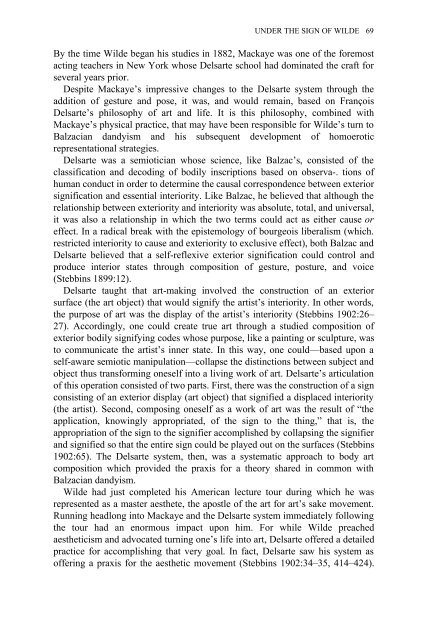Edited by Moe Meyer - Get a Free Blog
Edited by Moe Meyer - Get a Free Blog
Edited by Moe Meyer - Get a Free Blog
Create successful ePaper yourself
Turn your PDF publications into a flip-book with our unique Google optimized e-Paper software.
UNDER THE SIGN OF WILDE 69<br />
By the time Wilde began his studies in 1882, Mackaye was one of the foremost<br />
acting teachers in New York whose Delsarte school had dominated the craft for<br />
several years prior.<br />
Despite Mackaye’s impressive changes to the Delsarte system through the<br />
addition of gesture and pose, it was, and would remain, based on François<br />
Delsarte’s philosophy of art and life. It is this philosophy, combined with<br />
Mackaye’s physical practice, that may have been responsible for Wilde’s turn to<br />
Balzacian dandyism and his subsequent development of homoerotic<br />
representational strategies.<br />
Delsarte was a semiotician whose science, like Balzac’s, consisted of the<br />
classification and decoding of bodily inscriptions based on observa-. tions of<br />
human conduct in order to determine the causal correspondence between exterior<br />
signification and essential interiority. Like Balzac, he believed that although the<br />
relationship between exteriority and interiority was absolute, total, and universal,<br />
it was also a relationship in which the two terms could act as either cause or<br />
effect. In a radical break with the epistemology of bourgeois liberalism (which.<br />
restricted interiority to cause and exteriority to exclusive effect), both Balzac and<br />
Delsarte believed that a self-reflexive exterior signification could control and<br />
produce interior states through composition of gesture, posture, and voice<br />
(Stebbins 1899:12).<br />
Delsarte taught that art-making involved the construction of an exterior<br />
surface (the art object) that would signify the artist’s interiority. In other words,<br />
the purpose of art was the display of the artist’s interiority (Stebbins 1902:26–<br />
27). Accordingly, one could create true art through a studied composition of<br />
exterior bodily signifying codes whose purpose, like a painting or sculpture, was<br />
to communicate the artist’s inner state. In this way, one could—based upon a<br />
self-aware semiotic manipulation—collapse the distinctions between subject and<br />
object thus transforming oneself into a living work of art. Delsarte’s articulation<br />
of this operation consisted of two parts. First, there was the construction of a sign<br />
consisting of an exterior display (art object) that signified a displaced interiority<br />
(the artist). Second, composing oneself as a work of art was the result of “the<br />
application, knowingly appropriated, of the sign to the thing,” that is, the<br />
appropriation of the sign to the signifier accomplished <strong>by</strong> collapsing the signifier<br />
and signified so that the entire sign could be played out on the surfaces (Stebbins<br />
1902:65). The Delsarte system, then, was a systematic approach to body art<br />
composition which provided the praxis for a theory shared in common with<br />
Balzacian dandyism.<br />
Wilde had just completed his American lecture tour during which he was<br />
represented as a master aesthete, the apostle of the art for art’s sake movement.<br />
Running headlong into Mackaye and the Delsarte system immediately following<br />
the tour had an enormous impact upon him. For while Wilde preached<br />
aestheticism and advocated turning one’s life into art, Delsarte offered a detailed<br />
practice for accomplishing that very goal. In fact, Delsarte saw his system as<br />
offering a praxis for the aesthetic movement (Stebbins 1902:34–35, 414–424).


